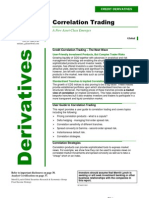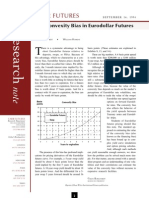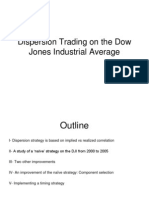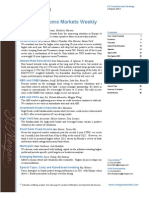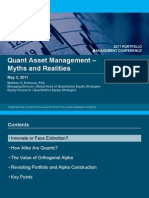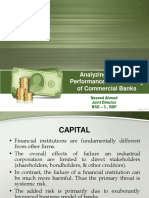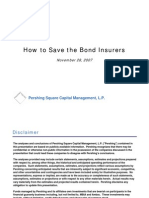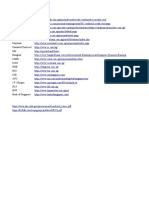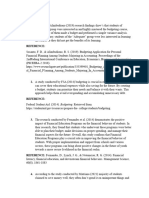Morgan Stanley 1 Final Portable Alpha
Morgan Stanley 1 Final Portable Alpha
Uploaded by
davrobCopyright:
Available Formats
Morgan Stanley 1 Final Portable Alpha
Morgan Stanley 1 Final Portable Alpha
Uploaded by
davrobCopyright
Available Formats
Share this document
Did you find this document useful?
Is this content inappropriate?
Copyright:
Available Formats
Morgan Stanley 1 Final Portable Alpha
Morgan Stanley 1 Final Portable Alpha
Uploaded by
davrobCopyright:
Available Formats
Chapter 1
Portable alpha: A PRACTITIONERS GUIDE
Unravelling the hype behind the latest phenomenon
by Jack Coates, Ph.D., CFA and Mark Baumgartner, Ph.D, CFA, Morgan Stanley Alternative Investment Partners*
Every now and then, there is a development in the world of finance that results in a major paradigm shift. Examples include the introduction of present value as a tool in financial decision making, 1 the Modigliani-Miller hypotheses regarding capital structure 2 and the introduction of modern portfolio theory in investing. 3 Today, we are in the midst of an unusual situation in which three paradigm shifts are emerging simultaneously. Each can have a significant impact on the management of the investment portfolios of pension funds, endowments and foundations.
The first of these developments is a growing focus on various types of asset-liability risk. The second is the recognition that defined benefit plan and endowment or foundation assets and liabilities are part of the capital structure of the sponsoring entity; they are thus subject to both corporate or trust financial principles and optimal portfolio theory. The third development is the use of portable alpha financial engineering techniques to help raise returns, reduce portfolio volatility, and/or achieve better asset-liability matching.
recently. The number of articles mentioning portable alpha has grown tenfold in the last three years, nearing the threshold of two new articles per day. What is driving this attention? As is true of any new idea or methodology, there is an incubation period during which it is vetted and tested by a few leading practitioners. As adoption accelerates and success stories spread, acceptance of the methodology occurs, often driven at exponential rates by word of mouth transmission. The media plays a key role at this dissemination of information stage. While we are still in the early stages of the portable alpha lifecycle, we
WHAT IS PORTABLE ALPHA? Portable alpha has been the focus of much media attention
are witnessing increasing adoption of these strategies by all types of institutional investors in a variety of sizes and approaches. 1
Chapter 1
Almost as fast as media coverage of portable alpha has grown, so has the variety and scope of definitions of portable alpha. Our definition is as follows: Portable alpha is a financial engineering methodology that seeks to add low correlation sources of return (alpha) to a portfolio while maintaining the total portfolios desired systematic (beta) exposures. An example is combining the returns from a low-risk fund of hedge funds (the alpha) with the returns from a fixed income or equity index (the beta) with the objective of outperforming the index by some meaningful amount with minimal additional risk. Part of the confusion surrounding portable alpha arises from the many ways it can be implemented, although this flexibility is also one of its most attractive characteristics. With portable alpha, almost any robust source of alpha can be transported to
virtually any asset class including cash, all types of equity and fixed income vehicles, and other categories such as commodities. Alpha may be transported to (1) any market index for which established derivatives markets exist, (2) any asset class that can be replicated using baskets of securities, or (3) any asset class for which an active or passive manager exists. A single, diversified portfolio of alpha-generating strategies can also be transported to multiple benchmarks simultaneously, making the process of alpha generation more efficient than would be the case if alpha had to be found separately for each asset class. Portable alpha vs. the traditional approach The traditional approach to institutional investment management begins with a committee setting target asset classes, and then choosing index funds or active managers within each class in the hope of finding those
The portable alpha approach
Exhibit 1
Alpha, from fund or hedge funds or private equity funds Embedded beta2 Beta1 from index or active manager benchmark
Alpha
Beta1 + beta2
Primary beta source
Alpha engine
Total return
Source: Morgan Stanley Alternative Investment Partners 2
Chapter 1
that are able to generate alphas above the passive asset class returns. For example, to fill a target equity allocation, investors would search only among equity managers; for a bond allocation, they would search only among bond managers. By focusing exclusively on managers within each class, however, investors limit the universe of strategies and managers from which to select and, hence, the opportunities to find the desired levels of alpha. Allocations to managers capable of generating the greatest alphas are excluded if they do not fit within the confines of the chosen asset classes. Portable alpha works quite differently. It is predicated upon the notion that portfolio objectives are best achieved when asset class decisions and manager selections are made independently. It is further based upon the separation of market-based and skill-based returns, and allocating most of a funds active management risk budget to alpha sources. A typical portable alpha strategy begins by selecting a well-diversified portfolio of the best alpha-generating managers, regardless of the asset classes in which they operate, with adequate consideration given to liquidity and risk. Once an attractive mix of managers is identified, the embedded market exposures (betas) in the portfolio are assessed. The investor then creates an overlay, employing futures, options, swaps or other contracts to add or subtract beta exposures to particular asset classes in order to achieve the desired total asset allocation. The objective is to set the overlay exposures so that they and the exposures embedded in the alpha sources sum to the investors target exposures (see Exhibit 1).
there are distinct advantages compared with traditional portfolio management, including: An expanded universe Investors are not forced to seek alpha only from managers within the target asset classes, opening a vast field of possible high-alpha strategies, such as certain types of hedge funds, private equity and opportunistic real estate, as well as a few traditional strategies. More tailored exposures The least efficient markets typically offer the best opportunities for alpha, but they might entail too much market risk for an investor. Portable alpha lets investors offset undesired exposures and/or capitalise on alpha from sources that do not have undesired market risks. Added flexibility An investor might reduce total portfolio risk by shifting the asset mix to one better suited to their risk objectives. For example, an allocation to equities could be reduced and fixed income and inflation-linked exposures increased, resulting in a better asset-liability match, additional inflation protection and a reduction in overall portfolio volatility while maintaining or even increasing potential expected returns. Increased efficiency Portable alpha allows the selection of alpha generating managers without regard to their asset classes. Alpha-generating managers often have low correlations with each other and can be combined into very efficient, risk-controlled portfolios. Reduced risk
ADVANTAGES OF PORTABLE ALPHA Portable alpha can provide a superior mix of alphas, while still achieving the desired aggregate betas. Although portable alpha can be challenging to implement and can add new management requirements,
By separating alpha and beta decisions, it is possible to allocate different amounts of a risk budget to each. For example, the alpha component can be large or small, unrelated to the amounts of the asset classes to which the alpha is transported. An initial small allocation to the alpha source might be increased as cumulative alpha is generated. 3
Chapter 1
The portable alpha spectrum
Exhibit 2
Optimal portable alpha zone Alpha potential (E(r)) Optimal active
Aggressive active
Too much risk Too little return Incremental active Pure indexing
Tracking error ( )
Source: Morgan Stanley Alternative Investment Partners
Lower fees With a portable alpha strategy, investors typically pay higher fees only to managers who add alpha, with lower costs for beta exposures.
often just a simple exchange of standard index exposures with a product that closely hugs benchmark indices. Investors who use this approach may miss some of the benefits that a more optimal portable alpha solution affords. An optimal portable alpha solution provides
USING PORTABLE ALPHA IN A PORTFOLIO CONTEXT At a recent investing conference, a consultant noted that many of her clients had implemented portable alpha in their portfolios. We have several investors already using these enhanced index strategies, she said. Claims such as these serve to illustrate the wide variety of ways the term portable alpha is currently being used. While traditional lower-alpha enhanced indexing is a form of portable alpha, it is perhaps more accurately classified as an incremental active strategy (see Exhibit 2). These types of strategies are 6
three distinct advantages over traditional portfolio construction approaches and other strategies. It can: 1) Add substantial additional expected returns to an asset class or portfolio; 2) Significantly decrease overall portfolio volatility; and/or 3) Facilitate a meaningful shift to asset classes that an investor prefers when returns for such classes can be enhanced. Referring back to Exhibit 2, incremental active strategies do offer a nominal additional expected return over the index, or the ability to decrease
Chapter 1
portfolio volatility slightly, but they do not allow meaningful shifts in allocations among asset classes within a portfolio they are simply a good index replacement for investors who want to achieve slightly index-beating returns. At the other end of the spectrum are the aggressive active alpha strategies, for instance, certain types of single-manager, single-strategy hedge funds that seek high alpha with little regard to risk. The higher volatility of these strategies makes it more difficult to discern whether a manager truly has skill due to the inconsistency of alpha provision. Such strategies may be appropriate for investors who have sophisticated controls in place and can tolerate the risks of such strategies, but in many cases investors in aggressive active strategies end up porting volatility to their portfolios rather than alpha. For most other investors, the optimal active zone is the sweet spot in the portable alpha spectrum. It provides
enough additional alpha to achieve meaningful amounts of increased return or allow meaningful risk-reducing shifts in allocations within portfolios (for example, from equities to fixed income) while still meeting total portfolio target returns.
SELECTING AN OPTIMAL ALPHA ENGINE Optimal portable alpha applications offer significant benefits, but finding an alpha engine that sits squarely in the optimal zone of the portable alpha spectrum is not simple. Unlike beta risk, alpha risk does not offer the expectation of additional returns in exchange for the volatility assumed, even in the long term. In fact, the expected long-term alpha for a randomly selected diversified basket of alpha sources is negative due to the fees an investor pays for active management. This puts a premium on the selection of high quality alpha sources for portable alpha applications.
Developing and managing an optimal alpha engine using a fund of funds approach
Exhibit 3
Sourcing
Analysing
Investing
Monitoring
Idea generation and screening
Due diligence
Portfolio formation
Risk management and monitoring
Pare down universe of hedge funds
Identify most promising hedge funds/strategies
Allocation to newly approved and existing managers
Ongoing investment and operational due diligence review
Source: Morgan Stanley Alternative Investment Partners 7
Chapter 1
and cash management of derivative settlements. The IMPLEMENTATION NUANCES At face value, portable alpha appears to be fairly straightforward, but there is an array of complex portfolio management challenges that must be faced once the alpha engine has been chosen: managing embedded betas, rebalancing overlays, trading sophisticated derivatives, and dealing with leverage and liability. Embedded betas A key term in our definition of portable alpha is low correlation returns. In practice, however, most sources used for alpha generation contain some embedded betas that is, they are not completely uncorrelated with the indices being used for systematic risk exposure (i.e., beta). To address this issue, an assortment of tools must be used to estimate, monitor, and adjust the market exposures embedded in the portfolio. Even so-called market-neutral funds have some embedded betas that must be considered when constructing an overlay. Although there are mathematical techniques to estimate embedded betas, the betas tend to fluctuate, can be indirect and relate to other variables, can be the result of skill that is desirable, and/or can result from other nuances. Judgement is required to determine when fluctuations are temporary noise versus when they reflect a true change in the underlying economic betas. Overlay management After assessing the amounts and patterns of betas embedded in an alpha portfolio, an investor can implement the desired amount of additional beta exposures using futures, options or swaps on the desired target indices (i.e., the overlay). Selecting and sizing derivatives requires precise analysis of multiple factors, including pricing, basis risk, optionality Leverage and liability One of the key risks in implementing a portable alpha strategy involves issues of leverage and liability. Direct implementers of portable alpha or separate account holders must be willing to engage in the necessary derivative transactions. Some investors, however, prefer to invest in a commingled account a pre-packaged limited liability vehicle or special-purpose vehicle (SPV) that limits the derivatives liability involved. There are costs and benefits to each approach, as detailed in Exhibit 4. Trading considerations The decision of how often and by what degree to adjust the overlay can be complicated, but manageable. Derivatives used in portable alpha can have quite different cash settlement requirements that need to be managed closely. For example, a swap will usually require only quarterly interest payments, with the gain or loss settled either at final expiration or, at the option of the investor, earlier. Futures, in contrast, require daily settlements. Once the architectural decision has been made regarding the kinds of derivative instruments to use for the overlay, significant trading expertise is involved in actually implementing the desired architecture. To do this efficiently requires close relationships with counterparties and brokers, in-depth knowledge of the market and derivative instruments, and experience in establishing contracts and agreements. embedded beta exposures of an alpha portfolio can change over time, and the sum of the embedded and derivative exposures will drift as markets move and alpha is generated. Ongoing monitoring and periodic adjustments of the overlay are necessary to address such effects.
Locating, analysing and accessing investments for an alpha-generating portfolio is very access-, labour- and 8
skill-intensive. The investor must have access to a continual stream of new ideas for alpha generation,
Chapter 1
Separate vs. commingled accounts
Consideration Alpha flexibility Beta flexibility Limited liability Disclosure Staffing and resources Internal expertise Financing costs Liquidity Minimums Fees Commingled product Restricted to the alpha engine of commingled vehicle Restricted to the beta of commingled vehicle Liability strictly limited to investment amount One line accounting might be possible depending on accounting rules No need for additional staff to manage and monitor Can rely on the expertise of the manager of the commingled fund for alpha selection, beta management, contract negotiation, rebalancing and cash management May be higher due to lower average creditworthiness Constraints at both commingled and underlying manager level Can have low minimums Expect somewhat higher fees commensurate with value provided by commingled manager Separate account
Exhibit 4
Composition of alpha engine can be tailored to clients needs and adjusted Beta choice can be much broader and dynamic subject to availability Liability extends to the total alpha and beta exposure Typically requires more disclosure of components of portable alpha Would require internal or external resources to manage beta and alpha exposures Requires an enhanced level of expertise
May be lower because creditworthiness of sponsor can be used in negotiating swaps Constraints at underlying manager level Higher minimum investment requirements Total fees can be lower depending on the pricing of service providers
Source: Morgan Stanley Alternative Investment Partners
along with relationships with and access to top-performing managers. During our more than 20 years of intense focus on locating alpha both as a plan sponsor and a fund of funds manager we have found the most compelling sources to be various types of alternative investments, such as selected subcategories of hedge funds, private equity and opportunistic real estate. The most attractive alternative strategies are continually changing. Further, the return dispersion between the best and worst performing strategies and managers can be very large in the field of the high alpha-generating alternatives, and the relative performance relationships among managers can change dramatically over long periods of time even for successful managers with long track records. Therefore, multi-manager, diversified alpha engines provide key strategic advantages in a portable alpha structure. Exhibit 3 demonstrates the steps involved in developing and managing an optimal alpha engine
using a fund of funds approach. In essence, an investor must first thoroughly understand each strategy and conduct extensive investment, staffing, process and operational due diligence on candidate managers. During this stage, experience-based qualitative evaluations of the manager must be conducted as a complement to quantitative analyses; correlations and other statistical properties among managers must be analyzed in order to optimize portfolio efficiency and risk, and investors must consider each managers capacity, evaluating the impact on returns of cash flows into the strategy. Finally, fees must be carefully evaluated relative to projected alpha, and managers of portfolios of alternatives and portable alpha strategies must continually monitor existing managers and search for attractive new ideas and managers. A fund of funds approach can be one attractive way to achieve these multiple tasks in a one-stop manner and obtain an optimal source of alpha for transport. 9
Chapter 1
Investors can address these traditional compromises by LIABILITY DRIVEN INVESTMENT (LDI) STRATEGIES transporting alpha onto a bond-style beta, potentially increasing returns while at the same time matching liabilities and reducing surplus risk. This bond-style beta can be tailored to reflect a particular pension fund's liability profile using combinations of interest rate and The increased desire for asset-liability matching and liability driven investment strategies is a compelling argument for the application of portable alpha in pension portfolios. Fixed rate and inflation-linked bonds are recognised as an ideal asset class to match pension funds liabilities. The value of these bonds responds to changes in interest and inflation rates in the same way as the present value of pension liabilities, thereby providing a good asset-liability match. However, most pension funds are wary of increasing their allocation to these bonds. One reason is the desire to avoid locking into historical low yields and hence low expected returns from bonds. Another reason is the limited opportunities to add alpha in high quality fixed rate bond markets and the comparatively much smaller inflation-linked bond markets. Differing inflation measures between countries and currency differences further limit most pension fund investors to domestic bonds, an even smaller universe in which to add alpha. inflations swaps which are closely matched to the funds fixed and inflation linked cash flows; their value will change in tandem with changes in the value of the fund's liabilities. These swaps fit naturally into a portable alpha strategy as they are unfunded instruments, meaning that the majority of the funds capital can then be invested in an appropriate alpha engine. The same criteria for selecting an optimal alpha engine as described earlier clearly apply: the combined LDI/ portable alpha solution requires a suitably risk controlled alpha engine targeting higher returns than those available from bonds and cash. This creates a combined portfolio of assets which exhibit the liability-matching features of a bond, and the return-generating features of an alpha engine credibly matching liabilities while at the same time providing a means to minimise the contributions required to reduce pension deficits and/or increase benefits to plan participants.
by Brandon Horwitz Morgan Stanley Investment Management
reluctant to because the expected fixed income returns IS PORTABLE ALPHA APPROPRIATE FOR YOUR PORTFOLIO? Although alpha can be transported to almost any asset class or portfolio, there are two situations that are particularly suited to a portable alpha application: (1) Portfolios with high allocations to index funds, lower-alpha enhanced index funds, or underperforming active equity or fixed income managers. These portions of the portfolio are prime candidates for replacement with a portable alpha solution. (2) Liability driven investment (LDI) strategies where plan sponsors would prefer to increase their exposure to fixed income, but are 10 Index funds An obvious use of portable alpha is to replace index fund allocations, which by definition offer little or no alpha. Presumably they are included in a portfolio to provide a very low-cost exposure to a desired beta. Portable alpha provides a way to retain the beta exposure provided by an index fund as well as augment potential returns. are well below required returns. Portable alpha can be used to help improve the performance of these low expected return asset classes without sacrificing the desired benefits of lower volatility detailed further in the boxed text on LDI strategies, above.
Chapter 1
Enhanced index funds As discussed, lower-alpha enhanced index funds can incrementally improve returns for a given beta, but they may not meaningfully impact overall portfolio performance (as measured by returns, volatility, or asset-liability matching from shifting allocations among asset classes). Also, as with any active manager, enhanced index funds may underperform their benchmark and their performance should be closely monitored and evaluated. It may be advantageous to replace allocations to such funds with pre-packaged portable alpha products based on similar underlying betas.
Underperforming active equity or fixed income managers Many traditional active equity or fixed income managers are good candidates for replacement by portable alpha, including managers who are: generating little or no alpha and/or charging high fees per unit of alpha; taking very limited active risk (benchmark hugging); exhibiting high correlation to each other; and exposed to undesired market factors.
Portable alpha provider checklist
Exhibit 5
Key questions to ask What are the primary objectives, applications, benefits and risks associated with your programme? What is your investment philosophy and process? What is your experience managing portable alpha programmes? Do you act as both alpha manager and beta manager? What is your primary alpha source and why?
What you should seek in a response These should be clearly described and comprehensively addressed. Should be comprehensive, thorough, and combine sophisticated quantitative processes with extensive experience. A lengthy track record is desirable this is especially important with entry by many new and inexperienced providers. Skill sets are different for each make sure your provider has experience in both areas if they are managing both sides. Look for high quality alpha in the optimal zone of the portable alpha spectrum (target at least 300 to 400 basis points over LIBOR, low volatility, low embedded beta). Seek strategies that can limit assets as appropriate to their investment strategy. High information ratios the ratio of alpha to tracking error are desirable. High and sustained information ratios indicate the potential presence of skill vs. luck. Check the sophistication of embedded beta tracking and monitoring, with low tracking error to benchmark betas. Look for low fees per unit of alpha; be alert for beta masquerading as alpha. No performance fee is earned if programme falls short of the benchmark.
What is the capacity of your strategy? What is your track record of alpha generation? How does that compare to traditional managers? What is involved in the beta overlay process? What value do you provide? How well have you tracked betas historically? What are your fees per unit of alpha? How does that compare to traditional managers? Do you earn a performance fee if your portable alpha programme does not beat the benchmark?
Source: Morgan Stanley Alternative Investment Partners 11
Chapter 1
Why pay high fees for what is essentially beta exposure? Make certain your fees are being exchanged for true benchmark outperformance.
alpha and beta and then seeking to optimise results from each component separately, investors may meaningfully increase returns while maintaining levels of market risk that are most appropriate to their objectives.
CHECKLIST FOR YOUR PORTABLE ALPHA PROVIDER Because of the complexity and cost involved in a portable alpha implementation, many investors are outsourcing their portable alpha mandates to third parties who offer some or all of the services involved (e.g., optimal alpha engine selection and provision, embedded beta estimation and monitoring, overlay implementation and management). If you decide to seek assistance from a portable alpha provider, consider asking the questions listed in Exhibit 5.
*The authors would like to thank Brandon Horwitz, Dominick Carlino and Scott Gregory for their contributions to this article. Notes: 1. 1 Fisher, I., 1930, The Theory of Interest (New York: Macmillan). 2. Modigliani, F. and Miller, M., 1958, The Cost of Capital, Corporation Finance and the Theory of Investment, American Economic Review, vol. 48, no. 3, p. 261297. 3. Markowitz, H., 1952, Portfolio Selection, The Journal of Finance, vol. 7, no. 1, p. 7791.
CONCLUSION The marketplace is still in the early stages of what we expect to be a massive shift by pension funds, endowments and foundations in the use of portable alpha to raise returns, reduce volatility, and/or achieve other objectives such as better asset-liability matching in LDI strategies. Investors are likely to increase their search for alpha, but the search is very access, skill- and labour-intensive. It requires a great deal of experience, extensive investment and operations due diligence, and access to the best strategies and managers. Portable alpha strategies can help improve portfolio performance for institutional investors of all stripes. By dissecting returns into their underlying components Jack Coates, Ph.D., CFA is a Managing Director and the Head of the Portable Alpha Team, and Mark Baumgartner, Ph.D., CFA is an Executive Director and Portable Alpha Portfolio Manager, of Morgan Stanley Alternative Investment Partners in West Conshohocken, PA. For further information, please telephone +1 (610) 940 5685 or e-mail: s.scott.gregory@morganstanley.com
Jack Coates Mark Baumgartner
Disclaimer: Risk considerations: Alternative investments are speculative and involve a high degree of risk. Alternative investments are highly illiquid and may have higher fees than those charged by traditional investments. A portable alpha strategy uses leverage and derivatives which can entail a high degree of risk. This article does not purport to provide, and should not be construed as, investment advice to any person or entity in any manner. Furthermore, this article does not constitute an offer, or a solicitation of an offer, to buy or sell any security or instrument or to participate in any trading strategy. The forecasts and opinions in this piece are those of the authors only as of the time of this writing (which are subject to change based on market, economic, or other conditions), are not necessarily those of Morgan Stanley AIP or Morgan Stanley Investment Management, may not actually come to pass, and should not be construed as recommendations, but as illustrations of broader economic theses. All information contained within is based on past performance and is not intended to be indicative of future results.
12
You might also like
- TAIL RISK HEDGING: Creating Robust Portfolios for Volatile MarketsFrom EverandTAIL RISK HEDGING: Creating Robust Portfolios for Volatile MarketsNo ratings yet
- (Merrill Lynch) Correlation TradingDocument38 pages(Merrill Lynch) Correlation TradingAnurag MehtaNo ratings yet
- Burghardt Hoskins The Convexity Bias in Eurodollar FutureDocument16 pagesBurghardt Hoskins The Convexity Bias in Eurodollar FutureMohamad KarakiNo ratings yet
- Winning On Wall Street (Revised Edition) by Martin ZweigDocument153 pagesWinning On Wall Street (Revised Edition) by Martin ZweigIris Wang100% (6)
- JPMorgan Cross Asset CorrelationsDocument28 pagesJPMorgan Cross Asset Correlationstanmartin100% (2)
- Volatility Signals For Asset AllocationDocument12 pagesVolatility Signals For Asset AllocationsoumensahilNo ratings yet
- Global Economics Paper - A Quantamental Approach To EM Local Rates InvestingDocument31 pagesGlobal Economics Paper - A Quantamental Approach To EM Local Rates InvestingtinatessariNo ratings yet
- Walmart Moneycard Bank StatementDocument2 pagesWalmart Moneycard Bank StatementClifton Wilson50% (2)
- Barclays Capital Equity Correlation Explaining The Investment Opportunity PDFDocument2 pagesBarclays Capital Equity Correlation Explaining The Investment Opportunity PDFAnonymous s41KVlqkNo ratings yet
- DB Breakeven Inflation Swap Guide v1.20101207Document3 pagesDB Breakeven Inflation Swap Guide v1.20101207Palmar SigurdssonNo ratings yet
- DynamicVIXFuturesVersion2Rev1 PDFDocument19 pagesDynamicVIXFuturesVersion2Rev1 PDFsamuelcwlsonNo ratings yet
- 2018 Equity Volatility Outlook Credit SuisseDocument47 pages2018 Equity Volatility Outlook Credit SuissePipi Ququ0% (1)
- JPM CDS Handbook 2006Document180 pagesJPM CDS Handbook 2006iceninedNo ratings yet
- Portfolio Representations: A step-by-step guide to representing value, exposure and risk for fixed income, equity, FX and derivativesFrom EverandPortfolio Representations: A step-by-step guide to representing value, exposure and risk for fixed income, equity, FX and derivativesRating: 5 out of 5 stars5/5 (1)
- Portable Alpha Theory and Practice: What Investors Really Need to KnowFrom EverandPortable Alpha Theory and Practice: What Investors Really Need to KnowNo ratings yet
- Inside the Yield Book: The Classic That Created the Science of Bond AnalysisFrom EverandInside the Yield Book: The Classic That Created the Science of Bond AnalysisRating: 3 out of 5 stars3/5 (1)
- Practical Relative-Value Volatility Trading: Stephen Blyth, Managing Director, Head of European Arbitrage TradingDocument23 pagesPractical Relative-Value Volatility Trading: Stephen Blyth, Managing Director, Head of European Arbitrage TradingArtur SilvaNo ratings yet
- Dispersion Trading: Many ApplicationsDocument6 pagesDispersion Trading: Many Applicationsjulienmessias2100% (2)
- Barclays Weekly Options Report Vols Die HardDocument10 pagesBarclays Weekly Options Report Vols Die HardVitaly ShatkovskyNo ratings yet
- Introduction To Interest Rate Trading: Andrew WilkinsonDocument44 pagesIntroduction To Interest Rate Trading: Andrew WilkinsonLee Jia QingNo ratings yet
- Stock Correlation (Natix!s Paper)Document10 pagesStock Correlation (Natix!s Paper)greghmNo ratings yet
- Index Variance Arbitrage: Arbitraging Component CorrelationDocument39 pagesIndex Variance Arbitrage: Arbitraging Component Correlationcclaudel09No ratings yet
- Dispersion Trading HalleODocument29 pagesDispersion Trading HalleOHilal Halle OzkanNo ratings yet
- Options - Capturing The Volatility Premium Through Call Overwriting PDFDocument12 pagesOptions - Capturing The Volatility Premium Through Call Overwriting PDFPablo RaffaelliNo ratings yet
- Short Volatility Positioning A Cause For Concern BarclaysDocument14 pagesShort Volatility Positioning A Cause For Concern BarclaysDanny LeeNo ratings yet
- JPM Correlations RMC 20151 KolanovicDocument22 pagesJPM Correlations RMC 20151 Kolanovicdoc_oz3298100% (1)
- BNP April 2012 PDFDocument28 pagesBNP April 2012 PDFcaxapNo ratings yet
- EDHEC-Risk Publication Dynamic Risk Control ETFsDocument44 pagesEDHEC-Risk Publication Dynamic Risk Control ETFsAnindya Chakrabarty100% (2)
- Quant Lab: Equity DispersionDocument10 pagesQuant Lab: Equity DispersionArnaud FreycenetNo ratings yet
- Corre L Swap PricingDocument17 pagesCorre L Swap PricingvidmantoNo ratings yet
- Intro Swap MKTDocument18 pagesIntro Swap MKTshih_kaichihNo ratings yet
- CDS Bond BasisDocument41 pagesCDS Bond BasisSharad DuttaNo ratings yet
- Dispersion - A Guide For The CluelessDocument6 pagesDispersion - A Guide For The CluelessCreditTraderNo ratings yet
- US Fixed Income Markets WeeklyDocument96 pagesUS Fixed Income Markets Weeklyckman10014100% (1)
- 3 30 Nick Firoozye PDFDocument30 pages3 30 Nick Firoozye PDFArnaud AmatoNo ratings yet
- TurboCarryZoomsAhead PDFDocument8 pagesTurboCarryZoomsAhead PDFkiza66No ratings yet
- Dispersion Trading: An Empirical Analysis On The S&P 100 OptionsDocument12 pagesDispersion Trading: An Empirical Analysis On The S&P 100 OptionsTataNo ratings yet
- (Dresdner Klein Wort, Bossu) Introduction To Volatility Trading and Variance SwapsDocument56 pages(Dresdner Klein Wort, Bossu) Introduction To Volatility Trading and Variance Swapstwilgaal100% (1)
- GS Cross Asset CarryDocument16 pagesGS Cross Asset CarryHarry MarkowitzNo ratings yet
- JPMQ: Pairs Trade Model: Pair Trade Close Alert (AGN US / BMY US)Document6 pagesJPMQ: Pairs Trade Model: Pair Trade Close Alert (AGN US / BMY US)smysonaNo ratings yet
- ACOMB-Correlation in PracticeDocument25 pagesACOMB-Correlation in PracticefloqfloNo ratings yet
- Volatility Radar: Profit From Low Vol and High SkewDocument14 pagesVolatility Radar: Profit From Low Vol and High SkewTze ShaoNo ratings yet
- GVS Vol 101 SlidesDocument19 pagesGVS Vol 101 SlidesJasonNo ratings yet
- Qis - Insights - Qis Insights Style InvestingDocument21 pagesQis - Insights - Qis Insights Style Investingpderby1No ratings yet
- Wai Lee - Regimes - Nonparametric Identification and ForecastingDocument16 pagesWai Lee - Regimes - Nonparametric Identification and ForecastingramdabomNo ratings yet
- MS&E448: Statistical Arbitrage: Group 5: Carolyn Soo, Zhengyi Lian, Jiayu Lou, Hang YangDocument31 pagesMS&E448: Statistical Arbitrage: Group 5: Carolyn Soo, Zhengyi Lian, Jiayu Lou, Hang Yangakion xcNo ratings yet
- Derivatives 2012Document44 pagesDerivatives 2012a p100% (1)
- Quantitative Asset Manage 102727754Document31 pagesQuantitative Asset Manage 102727754h_jacobson75% (4)
- Volatility - A New Return Driver PDFDocument16 pagesVolatility - A New Return Driver PDFrlpris100% (1)
- SkewDocument34 pagesSkewnblanc88100% (4)
- 2006 Loeys, J., Exploiting Cross-Market MomentumDocument16 pages2006 Loeys, J., Exploiting Cross-Market MomentumArthur FournierNo ratings yet
- Markowitz in Tactical Asset AllocationDocument12 pagesMarkowitz in Tactical Asset Allocationsoumensahil100% (1)
- DRKW Rate StructuringDocument20 pagesDRKW Rate StructuringLisa SmithNo ratings yet
- CBOT-Understanding BasisDocument26 pagesCBOT-Understanding BasisIshan SaneNo ratings yet
- Sectors and Styles: A New Approach to Outperforming the MarketFrom EverandSectors and Styles: A New Approach to Outperforming the MarketRating: 1 out of 5 stars1/5 (1)
- European Fixed Income Markets: Money, Bond, and Interest Rate DerivativesFrom EverandEuropean Fixed Income Markets: Money, Bond, and Interest Rate DerivativesJonathan A. BattenNo ratings yet
- The High Frequency Game Changer: How Automated Trading Strategies Have Revolutionized the MarketsFrom EverandThe High Frequency Game Changer: How Automated Trading Strategies Have Revolutionized the MarketsNo ratings yet
- CLO Liquidity Provision and the Volcker Rule: Implications on the Corporate Bond MarketFrom EverandCLO Liquidity Provision and the Volcker Rule: Implications on the Corporate Bond MarketNo ratings yet
- Fixed Income Relative Value Analysis: A Practitioners Guide to the Theory, Tools, and TradesFrom EverandFixed Income Relative Value Analysis: A Practitioners Guide to the Theory, Tools, and TradesNo ratings yet
- Econ 3658 Answer of Spring 2021 Exam 3Document7 pagesEcon 3658 Answer of Spring 2021 Exam 3Adam YoussefNo ratings yet
- 14 SPL311229933 Applicant BANK STATEMENT.Document1 page14 SPL311229933 Applicant BANK STATEMENT.86jaibalajiNo ratings yet
- Internal Reconstruction - ProblemsDocument8 pagesInternal Reconstruction - ProblemsNaomi SaldanhaNo ratings yet
- 01 ABM Financial Accounting Session1Document36 pages01 ABM Financial Accounting Session1DentatusNo ratings yet
- Paper1 With Cover Page v2Document18 pagesPaper1 With Cover Page v2Palash WanwaniNo ratings yet
- Statement of Account: Date Narration Chq./Ref - No. Value DT Withdrawal Amt. Deposit Amt. Closing BalanceDocument5 pagesStatement of Account: Date Narration Chq./Ref - No. Value DT Withdrawal Amt. Deposit Amt. Closing BalanceNanu PatelNo ratings yet
- Day 2 Slides (Rev)Document48 pagesDay 2 Slides (Rev)AHMAD RANANo ratings yet
- PBI - Unit 3-Loans and AdvancesDocument59 pagesPBI - Unit 3-Loans and AdvancesAmit PatelNo ratings yet
- How To Save The Bond Insurers Presentation by Bill Ackman of Pershing Square Capital Management November 2007Document145 pagesHow To Save The Bond Insurers Presentation by Bill Ackman of Pershing Square Capital Management November 2007tomhigbieNo ratings yet
- Impact of Crude Oil Price On Indian EconomyDocument5 pagesImpact of Crude Oil Price On Indian EconomySri LakshmiNo ratings yet
- Initiating The Deal: The Buyer's PerspectiveDocument7 pagesInitiating The Deal: The Buyer's PerspectiveyasserNo ratings yet
- ExportTable V4Document42 pagesExportTable V4Nhật ThànhNo ratings yet
- Interim Financial ReportingDocument4 pagesInterim Financial Reportingbelle crisNo ratings yet
- Fria Mae Abellano - International Business and TradeDocument14 pagesFria Mae Abellano - International Business and TradeFria Mae Aycardo AbellanoNo ratings yet
- Module-1 Intro To AccountingDocument4 pagesModule-1 Intro To AccountingPam Salalima AlemaniaNo ratings yet
- The Fundamentals of Investing PPT 2.4.4.G1Document36 pagesThe Fundamentals of Investing PPT 2.4.4.G1Isabelle VershawNo ratings yet
- The Forgotten Lessons of 2008 by Seth KlarmanDocument4 pagesThe Forgotten Lessons of 2008 by Seth KlarmanArgha PaulNo ratings yet
- Alternative Investment Funds: DR Jayendra KastureDocument16 pagesAlternative Investment Funds: DR Jayendra Kastureprarthana rameshNo ratings yet
- Pas 20 Accounting For Government Grants and Disclosure of Government AssistanceDocument2 pagesPas 20 Accounting For Government Grants and Disclosure of Government AssistanceR.A.No ratings yet
- Tugas05 AKM1M 21013010130 Shavira Aisyah MaharaniDocument7 pagesTugas05 AKM1M 21013010130 Shavira Aisyah MaharanicaNo ratings yet
- Business FundamentalsDocument7 pagesBusiness FundamentalsjfasldjflakdjqdfNo ratings yet
- 5 LOCAL RRL and 1FS of AshengDocument3 pages5 LOCAL RRL and 1FS of Ashengfabian.altheajaneNo ratings yet
- British Pound SterlingDocument2 pagesBritish Pound SterlingAsir Awsaf AliNo ratings yet
- Fixedline and Broadband Services: Your Account Summary This Month'S ChargesDocument2 pagesFixedline and Broadband Services: Your Account Summary This Month'S ChargesJeneshNo ratings yet
- Finance AssignmentDocument12 pagesFinance AssignmentYanni PoonNo ratings yet
- Chapter 3 CLCDocument24 pagesChapter 3 CLCVăn ThànhNo ratings yet
- Group Financial ControllerDocument10 pagesGroup Financial ControllerPost PictureNo ratings yet
- Business English Taboo Cards - Business EnglishDocument6 pagesBusiness English Taboo Cards - Business EnglishMateusz100% (1)

